|
|
|
|
Rethinking Nationalism in the Arab Middle East, by Israel Gershoni and James Jankowski, editors
6. Nationalist Iconography: Egypt as a Woman
Beth Baron
A nation is an abstraction. That is, it has no material form. Yet from the rise of nationalism, the nation has been represented visually.
1
The purposes of such representations are clear. Images of the nation are meant to reaffirm the unity of the nation and give the concept of nationhood greater immediacy. In societies such as those of the Middle East, where large segments of the population remain illiterate, they are also meant to disseminate the idea of nationalism. The nation is thus an "imagined community"
2
that is sometimes imagined in human or other form. When the nation has been personified, it obviously appears as either a male or female figure. The selection and subsequent attributes associated with the chosen figure give insights into a particular nationalism and illuminate gender roles in a new nation-state.
This essay analyzes the visual representations of the Egyptian nation from the 1870s through the 1930s. A variety of forms will be examined, including paintings, sculptures, and cartoons. Images were generated under diverse circumstances by a variety of artists and others for different audiences. We will consider the context of creation of these works, their intended meanings, and their reception by Egyptian audiences. We will see that over time, and with few exceptions, Egypt came to be depicted as a woman.
It could be argued that the idea of representing the nation as a woman, like the idea of nationalism itself, had come from abroad. Derived from the European model in general or the French precedent in particular (Marianne), it would thus be one more example of an almost universal practice. Yet local traditions had a significant impact on the production of images of the nation, making the indigenous imprint extremely important and the nationalist iconography of Egypt at times unique.
First, Egypt came to be represented as a woman in a process that coincided with the unveiling of Egyptian women. This was not a self-evident or seamless process but, rather, one that took time. Egypt could not effectively be represented as a woman until the debate on unveiling had advanced in the early 1900s and the urban elite women who wore a face covering had begun to unveil in the century's teens and twenties. Unveiling then became a metaphor for independence. Second, this female image was not a mere importation of the French Marianne or of other European representations. The images of the Egyptian nation as a woman reflected something of the social situation of Egyptian women and of the local discourse on their place in society. Unlike the barebreasted Marianne, Egypt only bared her face, and in general she respected local customs pertaining to modest dress. Third, no one image of the nation emerged. Rather, there was a multiplicity of images, of young and old, healthy and ailing, Pharaonic and Islamic, urban and rural women. The multiplicity indicated a measure of confusion about the content of Egyptian nationalism and its direction. It suggested that the notion of "nation" in Egypt was still fluid and that Egypt was not yet a coherent collective.
Some of the earliest images of the Egyptian nation came from the pen of Ya'qub Sanu'a, an Egyptian nationalist educated in part in Italy and no doubt influenced by the arts there. Sanu'a was a man of many talents who in the early 1870s wrote and produced plays, founding native Egyptian theatre. In 1877 he started a satirical weekly called Abu Naddara Zarqa' (the man with the blue glasses). Only fifteen issues of the handwritten journal appeared before an angry Khedive Isma'il expelled Sanu'a from Egypt. Sanu'a took up residence in Paris, where he continued to produce his journal under various titles for decades, adding French to the colloquial Arabic.
Sanu'a's journal circulated widely in its early days, according to contemporary observers. Blanchard Jerrold wrote that the satire in the second issue "was so thoroughly to the taste of the public, that the paper was sold in immense quantities. It was in every barrack, in every Government-office. In every town and village it was read with the liveliest delight." Jerrold claimed that the journal subsequently "found its way into every village, and was read universally." If they could not read, he explained, the fallah "learned to listen with delight to the satire of the Abou Naddarah." 5 Once Sanu'a moved overseas, he had the banned journal smuggled back into Egypt using various devices. Copies were hidden in the pages of art books and large journals or in the luggage of Egyptian travelers. One poverty-stricken woman carried the journal home in her bedding. 6 Circulation figures for Abu Naddara have been variously estimated, the most reasonable being 3,300 per issue. 7 Because papers were passed from hand-to-hand and read aloud, scholars of the Arabic press suggest that circulation numbers ought to be multiplied for a more accurate accounting of distribution. 8 And to readers and listeners, we must add viewers, for Sanu'a introduced cartoons to the Egyptian public.
Sanu'a himself often appeared in the cartoons, in the garb of a shaykh or otherwise dressed and always wearing glasses, the perennial observer. Unlike cartoons of the 1920s and 1930s, which spared the monarch, Sanu'a's cartoons incessantly attacked Khedive Isma'il and his successors as well as ministers and foreign officials. John Bull and representations of other European nations made frequent appearances in the pages of Abu Naddara. Convenient symbols for the great powers, they could be easily caricatured. 10 Sanu'a also depicted the Egyptian nation in various guises. One series of cartoons showed Egypt as a cow (occasionally with the head of the Sphinx) being milked dry by ministers and by the European powers, or actually sucked by foreigners. Fat or lean, the cow appeared as a passive victim. 11 Egypt also appeared as a donkey: Isma'il sat astride the animal as his sons and associates beat it in an attempt to steal it. 12
Sanu'a represented Egypt as a woman from time to time. In the early 1880s Egypt appeared twice as an ailing Pharaonic queen (figure 6.1). 13 European excavators had begun to unearth Pharaonic treasures from the mid-nineteenth century, providing artists and intellectuals with new motifs and designs. The decision to depict the nation in Pharaonic garb thus reflected the impact of Egyptology on Egyptians. But there were also few female alternatives. Sanu'a showed Egypt as a fully veiled woman in 1894; the woman representing Egypt stands next to women representing France and Russia and in front of a female Britannia (figure 6.2). 14 The contrasts are compelling and suggest the artistic and ideological limitations of depicting Egypt as an Islamic woman with no visage. Nationalism was meant to be a modernizing force, but a fully veiled woman in the mid-1890s did not represent modernity. Sanu'a himself was a man of liberal ideas who had critiqued the situation of women in Egyptian society in his plays and attacked institutions such as polygamy. Yet until the debate on unveiling had begun, he could not easily use contemporary women as representations of Egypt. This image, in any case, was not repeated in the pages of Abu Naddara.
The importance of visual matter in Abu Naddara should not be underestimated, given the low literacy rates of the day. But would viewers have easily understood the cartoons? A knowledge of Egyptian and European politics would seem important, and the captions in Egyptian dialect (and French) under the cartoons no doubt clarified meanings. But the cartoons could have been appreciated on a number of levels. They caricatured familiar figures and drew on local humor. Verbal antecedents to the cartoon could be found in indigenous Egyptian humor: folktales (in particular the Goha repertoire), proverbs, zajals, (rhymed prose), and nuktas (verbal cartoon or joke). 15 Still, one should not assume that illiterate Egyptians had a visual literacy and understood the signs and symbols used in cartoons. Reading pictures was a skill that had to be learned. 16
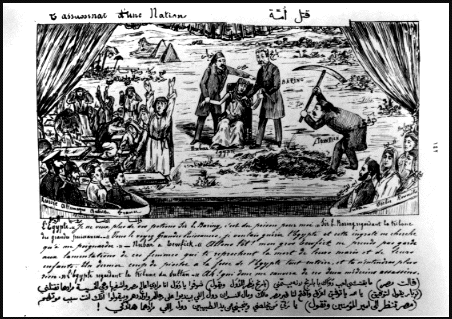
Ya'qub Sanu'a followed events of the 1881-1882 'Urabi Revolt closely, commenting upon them both editorially and visually. In the period following the exile of many of those who had backed 'Urabi, Sanu'a continued to articulate and illustrate a pro-French nationalist position. His significance diminished with the emergence of Mustafa Kamil and a younger generation of nationalists. These men developed their own organs, such as the newspaper al-Liwa', which did not favor the cartoon as a political expression (given its pan-Islamic bent, it avoided human images altogether). With the odd exception, the cartoon seems less conspicuous in the press. 17 This may have been a matter of Mustafa Kamil's style, the simple absence of illustrators with a bent toward humor, or a focus on a narrower, more literate audience. For early images of the nation, we must turn toward other art forms.
Mustafa Kamil's initial strategy, like that of Sanu'a, was to appeal to the French to pressure the British to leave Egypt peacefully. When Mustafa Kamil presented the president of the French Chamber of Deputies with a petition in 1895 requesting French aid in evicting the British from Egypt, he also gave him a painting (figure 6.3). This work, reproduced in 'Ali Fahmi Kamil's biography of his brother and later in 'Abd al-Rahman al-Rafi'i's book on the nationalist leader, depicts Egypt as a captive of the British. In the foreground an Egyptian with clothes stripped to the waist sits with back to the viewer and hands chained; the chains are held in the claws of the lion of Great Britain lying to the right; to the right of the lion sits a barechested soldier, sword in hand and eyeing Egypt suspiciously. Behind this group an Egyptian wearing European dress and a tarbush (fez) hands a document to an allegorical woman symbolizing France and justice. To his left a group of male Egyptians stands in tarbushes and turbans, waving the Ottoman-Egyptian flag; to the right women representing nations that the French had helped to achieve independence observe the scene. 18
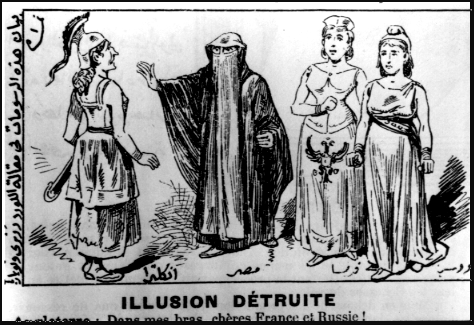
The figure representing Egypt is ambiguous. The physique appears to be that of a man. Yet 'Ali Fahmi Kamil writes that it is a woman. 19 Whether he makes that claim because he knew the original intent of the work, or because by the time he published his book over a decade later, Egypt was consistently depicted as a woman, is unclear. If it is a woman (as it probably was meant to be), it is consistent with the other nations rendered as women in the picture. Although her partial nakedness might be considered shocking, it is only implied and not revealed, as her back is towards us.
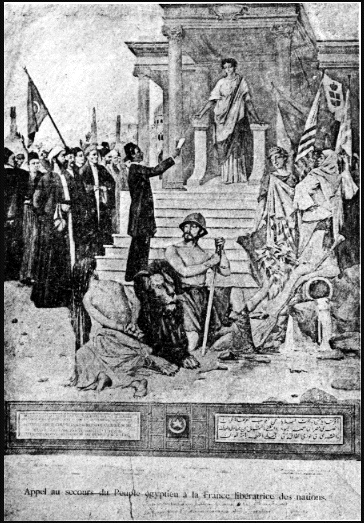
It is unlikely that this work was painted by an Egyptian, as the first generation of modern Egyptian painters were still in their infancy. It was therefore almost certainly painted by a Frenchman commissioned for this job. How widely viewed was this image? Mustafa Kamil presented the original painting to French officials, but thousands of copies were made of the picture and distributed to the international press. 20 Presumably some copies circulated in Egypt, appearing in the press there. Would those Egyptians who saw this picture have comprehended the symbolism? The law students who comprised an important segment of Kamil's followers might have; the uneducated would not have read the signs so easily. It seems, in any case, to have been primarily intended for a foreign audience.
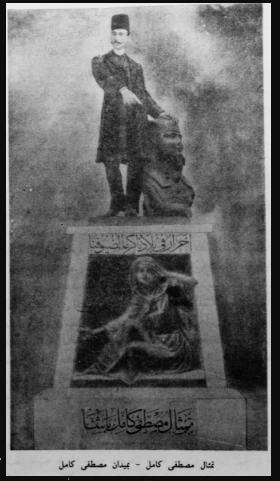
After Mustafa Kamil died in 1908, a committee was formed to commission a statue of the youthful nationalist. Since the School of Fine Arts had opened in Cairo only that year, no local artist yet had the requisite skills to create a monument in metal. The memorial committee thus chose a famous French sculptor based in Paris to cast the work in bronze. 21 But when we examine the monument, we can probably assume that the sculptor had to comply with the committee's design for the work or at least with their expectations for it.
The statue shows Mustafa Kamil standing erect delivering a speech (figure 6.4). He places his left hand on top of a bust of the Sphinx, which evokes Egypt's past glory, and points down with his right hand. The extended forefinger of his right hand draws us to the pedestal of the statue, which proves most intriguing for our purposes. A raised bronze shows a seated peasant woman of about the same dimension as Mustafa Kamil. Entrapped in the square space, the peasant woman represents Egypt under British occupation. She listens to the speaker and with her right hand implores that others do the same. Her left hand draws aside her veil in a gesture that signifies a desire for liberation. 22
That the monument to one of Egypt's earliest nationalists depicted the nation as a peasant is not surprising. Many nationalisms celebrate male and female peasants as "culturally authentic." Peasants have a concrete tie to the land, which is, after all, central to the claims of territorial nationalists. In the case of Egypt, depicting the nation as a peasant emphasized the agrarian nature of society. Yet the celebration of Egyptian peasants shows a significant break with earlier elite attitudes toward them. The Turco-Circassian aristocracy had despised the peasantry, and the elevation of the peasant as the embodiment of the nation coincided with the former's declining influence. Moreover, the generation that was coming to the helm of Egypt prided itself on its "peasant" (that is indigenous Egyptian origins) as opposed to the "foreign" Turco-Circassian elite, even though the men on the rise were landowners rather than laborers on the land.
The statue of Mustafa Kamil was delivered to Egypt in 1914 in the midst of a debate on whether or not Egyptian women ought to remove their face coverings. Unveiling meant different things to proponents and opponents of the step. Writers in the journal al-Sufur, founded in 1915, argued for unveiling (this is the meaning of al-sufur) whereas those in the weekly al-'Afaf (Virtue), founded in 1910, opposed the greater mixing of men and women that unveiling would inevitably bring. The cover of the latter journal had initially carried the picture of an Egyptian peasant woman with an opaque head scarf drawn across her face, but the editor subsequently blotted out the woman's facial features below her eyes. Both sides of this debate had come to see women as symbols of the nation, either of its backwardness, as in the case of the intellectuals around al-Sufur, or of its purity, as in the case of those writing for al-'Afaf. 23 The appearance of a woman as the representative of Egypt on the pedestal of the statue commemorating Mustafa Kamil expressed this sentiment artistically. The irony is that Mustafa Kamil was not a proponent of unveiling. To be sure, peasant women had never worn the same sort of face covering [hijab] that elite women had. They dressed modestly and covered their heads, and if they needed to they drew the head scarf across their faces. Their work in the fields and elsewhere made strict veiling and the seclusion that it suggested impractical. The differences between the veiling practices of rural and urban women were pointed out in the press. Still, a peasant woman unveiling came to represent the nation in its struggle for independence in a conflation of symbols.
By the time the monument arrived in Egypt, Kamil's successor, Muhammad Farid, had gone into exile and his party had fragmented. Although the statue was originally intended as an official memorial, it was barred from public exhibition. Neither the British nor the Khedive would have permitted this in 1914. Instead the statue was erected in the courtyard of the school Kamil had founded, where it no doubt became a familiar sight to schoolboys. Set as it was on private grounds, the statue did not have nearly the size audience that it later gained when it was moved to a public square in 1938. 24
The spread of renderings of Egypt as a woman was impossible until the debate on unveiling had reached a certain level. Yet it was no accident that debates on unveiling coincided with the rise of nationalism. Both were tied to the question of modernity. Moreover, the endeavor of building a nation-state required the mobilization of the entire population, male and female, and women had participated in the nationalist movement from its rise. In the 1890s they started journals promoting a domestic ideology posited on women's role as "mothers of the nation" whose job was to inculcate their sons and daughters with patriotism. They formed charities pioneering social reform in the name of national revival. Decades of organizing prepared elite women for public action, and in 1919 they marched in protest against British policy in Egypt, taking a visible role in the 1919 Revolution. 25
Inspired by the events of that revolution and influenced by the Mexican muralists, Muhammad Naji painted a vibrant tableau in 1919. The monumental oil on canvas bears the title "The Awakening of Egypt [Nahdat Misr], or the Procession of Isis" and contains Pharaonic and rural motifs. Here Egypt is represented as the queen-goddess Isis. She rides alongside the Nile in a chariot drawn by a water buffalo surrounded by male and female peasants. The procession is slow and colorful, suggesting historic motion and the march toward freedom. Naji's mural has hung in the hall of the Egyptian National Assembly since 1922. 26 Although displayed in a public building, one cannot presume all Egyptians could view the work. Women were denied access to the parliament in its early days, and the parliament was closed even to its own members under certain cabinets.
Images of women representing the nation multiplied in the 1920s as Egypt gained quasi-independence. This trend can be partially attributed to the proliferation of one specific image: Mahmud Mukhtar's "Nahdat Misr." As a village youth, Mukhtar had shown a talent for sculpting. He became one of the first graduates of the School of Fine Arts and went on to Paris to continue his studies. There in 1920 he won a prize for a model of "Nahdat Misr." Enthusiasm for his success abroad resulted in a campaign to have the sculpture enlarged and erected in the square in front of the Cairo train station. Pink granite quarried in Aswan was floated down the Nile in conscious imitation of the production of Pharaonic monuments. It took Mukhtar almost until the end of the decade to complete the costly project, but finally in 1928 the sculpture was presented to the public with great fanfare (figure 6.5). 27
The work juxtaposes two images: the Sphinx rising and a peasant woman unveiling. Both the Sphinx and the woman represent Egypt, one the ancient civilization, the other the modern nation. The Sphinx rising suggests a rebirth of Egypt's ancient grandeur; the peasant woman lifting her veil symbolizes the liberation of the nation. The linking of the two figures--the woman's hand rests on the Sphinx's head--connects antiquity to the present. 28 Some of the elements of the Mustafa Kamil statue are thus repeated, only the man himself is missing.
Critics acclaimed Mukhtar's "Nahdat Misr." Since the sculpture was erected in a busy square through which all those who came to Cairo by train had to pass, it had a captive audience. Even foreign travelers noticed the sculpture. "The visitor to Cairo is greeted on his arrival, as he passes out of the station, by a statue on the Station Square called The Awakening of Egypt," reported the American tourist Ruth Woodsmall. "On his departure from Cairo this statue remains his last impression." 29 Yet well before the final work was unveiled, the model had become familiar to many Egyptians. The journal al-Nahda al-Nisa'iyya (the Women's Awakening), founded in July 1921, often carried a picture of the model in profile on its cover. 30 Cartoons in al-Kashkul, a satirical journal also founded in 1921, parodied Mukhtar's effort to complete and display the statue through the decade. 31
The 1920s witnessed the reemergence of the cartoon as an important medium for conveying political and social critique. Two journals dominated the field, offering contrasting caricatures of national types. In Ruz al-Yusuf, a pro-Wafd weekly founded in 1925 by the actress Fatima al-Yusuf, the Egyptian character al-Misri Effendi became quite popular. A short, rounded figure, he wore a European-style suit and a tarbush (symbol of the new middle class) and carried prayer beads. However, this character represented "Mr. Average Egyptian" rather than the nation per se (which was occasionally depicted as a woman). 32 Launched in 1929, the character al-Misri Effendi soon spread to other periodicals. According to the cartoonist Muhammad Rakha, who helped to create its successor, in 1941 the chief editor of al-Ithnayn and the editorial staff of Dar al-Hilal decided that the caricature no longer symbolized the Egyptian character because, as Rakha relates, "it represented the lowest class of government official, that is the effendi class, or petty bureaucrats." They concluded that "the personality of an ibn al-balad [son of the people] represented a more independent and emancipated personality and one which really represented the Egyptian." 33 Rakha's comments shed light on the process by which certain caricatures were created. Decisions about what images to present to readers and viewers were often taken at the highest level by the editor and staff.
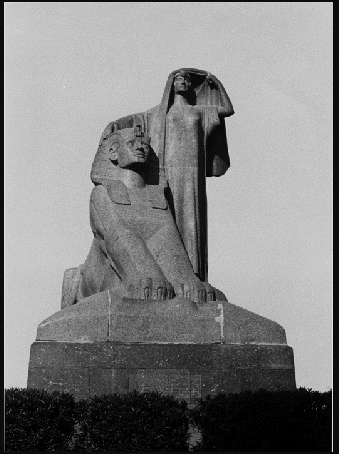
Whether this was the case at al-Kashkul (Scrapbook), a major rival of Ruz al-Yusuf, is not apparent. Edited by Sulayman Fawzi from the time it first appeared in May 1921, al-Kashkul introduced a new sort of satirical political journalism into Egypt. 34 It lampooned the government, assailing its weakness in dealing with the British, and condemned corruption in the Wafd. The paper appeared weekly, with a format of four full-page color car toons in each issue of sixteen or more pages in its first decade, and ran until after World War II. 35 i>Al-Kashkul's cartoons played on familiar themes and were probably comprehensible to many Egyptians. The caricatured figures were generally well-known, and the captions were in colloquial Arabic and could have been read aloud to the illiterate. Among the most popular weeklies in the interwar period, al-Kashkul had a circulation estimated at ten thousand in 1927-1928. 36 This was considered sizable at a time in which high illiteracy rates and the cost of ten milliemes per issue (or just over fifty piastres a year) would have precluded mass distribution. Its broad circulation and stinging satire no doubt irritated those government officials who came under attack, and upon at least one occasion the editor was arrested for insulting public officials in the pages of his paper. On that occasion a car toon had shown the then Prime Minister, Sa'd Zaghlul, as an organ-grinder. 37
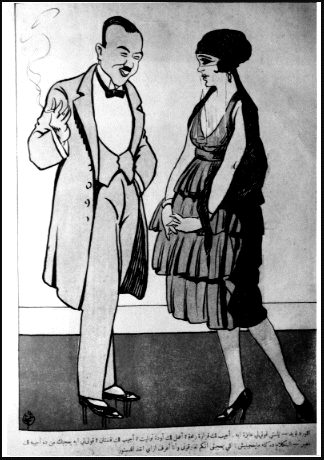
A series of cartoons in al-Kashkul depicted Egypt as a woman. The image was not fixed, however, and several "Egypts" ran through the 1920s and early 1930s, differing in age, size, and attributes in spite of the fact that most seem to be by the same hand. The most prevalent image of Egypt in the cartoons is that of a young woman (figure 6.6). She wears contemporary European dress, gloves, and high-heeled shoes along with a head scarf, a very light face veil, and a cloak. Her clothes change over the course of the decade: her cloak and dress become shorter, the gloves come off, the veil is removed, and she carries a clutch pocketbook. She even sports a fur wrap, indicating an elite background. That she oversees the cook, but does not cook herself, confirms this status. She travels, drives a car, and mixes with men. In short, she is the "new woman" of the age, educated and sophisticated, the counterpart to al-Kashkul's al-Misri Bey, who occasionally appeared, and a step above Ruz al-Yusuf's al-Misri Effendi. 38
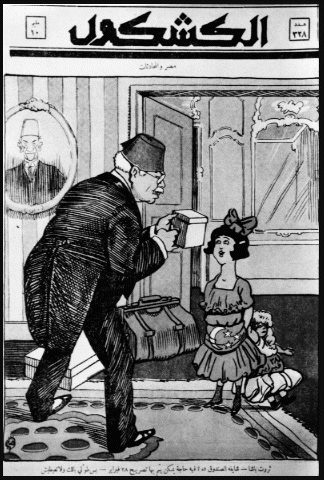
A second image shows a younger Egypt. She wears bows in her hair and bows on her dress, which is often decorated with the stars and crescent of the Egyptian flag. She is not just younger but smaller and appears weak and prone: she plays on a beach when suddenly the peace is disturbed by British planes and warships; she is accosted by foreign men (John Bull and others) who grab her; and she is befriended by Egyptian politicians (figure 6.7). Whereas British personalities and Egyptian politicians appear sinister and devious, she represents innocence and purity. 39 A third image is that of a rural woman, wearing a peasant scarf, ankle bracelets, and no shoes. Less sophisticated than the "new woman," she is more sensual. She is also more abused: she appears tied to a chair and gagged (figure 6.8), and in chains and blindfolded. In addition, she conveys more emotion: in one cartoon she wails at the side of a grave. 40 Yet the cartoonist at al-Kashkul did not tie himself to these sets of images, and he continued to create new ones. Egypt gives birth to the constitution, lies in a sick-bed attended by male politician-doctors, and appears weak and emaciated with a walking stick. 41
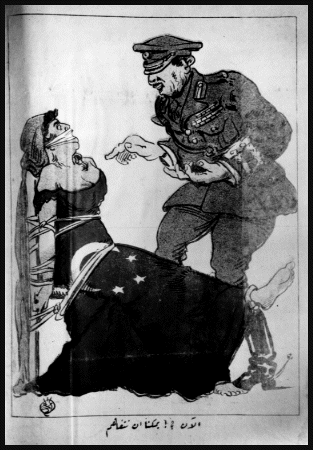
These are political cartoons concerned primarily with critiquing government policy. Yet we cannot ignore other levels of meaning. These cartoons convey their messages through caricatures that are based on widespread perceptions about gender and power, and they rely on sexual illusions as metaphors for politics. The sexual innuendo gives the artist almost unlimited opportunity for political critique. Egypt as a woman plays opposite to England's John Bull (figure 6.9), who is preferred to the female Britannia, as well as to Egypt's male politicians (there are no female ones). The Egyptian nation is wooed and pursued, and occasionally punished. In this way, the cartoons provide an outlet for expressions of sexuality that would be proscribed in other media, and they give a running commentary on contemporary gender relations. Because of her status in society, a woman could easily suggest the attributes associated with colonial occupation: as occupied as opposed to occupier, she was passive, prone, and weak. She also represented powerlessness and purity in the face of the corruption of Egyptian politicians.

The cartoons also contain explicit and implicit messages about race and class. Egypt almost always appears with a fair complexion, whether she is a young girl, "new woman," or peasant. By comparison, the Sudan--depicted as a nearly naked woman and in other guises--has darkened skin and exaggerated facial features. The Egypt of al-Kashkul is clearly not akin to territories to the south and of the African continent but closer in resemblance and style to European neighbors to the north. Egypt is also, with some exceptions, depicted as a woman of means. This is not surprising, as notables--lawyers and landowners--dominated Egyptian politics in the 1920s and 1930s. One wonders what appeal an elite woman of this sort would have had as a symbol of the Egyptian nation to a broader audience. Would she have evoked sympathy? Perhaps she would have in an age of paternalistic politics and of a different class consciousness.
In any case, it was convenient for the cartoonist at al-Kashkul to depict Egypt as a woman at a time when women had not been elected to the parliament or entered the cabinet. It was unlikely that she would be confused, as a male figure might have been, with a living personality. With the notable exceptions of Huda Sha'rawi, Nabawiyya Musa, Safiyya Zaghlul, and Fatima al-Yusuf, few real women appeared in the cartoons.
Not surprisingly, those sculptors, painters, cartoonists, and others who depicted the nation as a woman in various media were mostly male. While they presented the typical Egyptian--such as al-Misri Effendi--as male, they rendered the collective female. The man was the citizen; the woman was the nation. The artists who produced these images of the nation probably imagined their audience as male as well. Representing the nation as a woman was meant to tap notions of honor and instill in male viewers the sense that they had the duty to support, protect, and defend it. 42 Yet honor was not the only sentiment at stake. These images were intended to generate a romantic attachment to the nation and encourage a fusion with it. By depicting the nation as a woman, nationalists hoped to stimulate love for the nation and draw male youth to the cause. The images thus drew on emotions associated with gender and sexual relations. The man was the actor, the speaker, the lover; the woman was the acted upon, the listener, the beloved.
The audience of these images differed in size and composition. The paintings had the most limited consumption, hung as they were in restricted quarters. Yet replications circulated. The sculptures that appeared in public squares had a wider audience, though one of a limited circumference. Cartoons could have been consumed by the illiterate, who often gathered around newspaper readers to hear sections of a paper read aloud and would have seen the pictures. Seeing did not necessarily guarantee visual literacy, however. Visual representations have their own signs and symbols, which may not be apparent to all viewers. Even if understood, an image may not have resonated with its audience. Still, visual representations would have reached a much broader segment of the population than print culture and would have operated on a more visceral level.
Women did not seem to protest the nationalist iconography representing the nation as a woman. The women's journal al-Nahda al-Nisa'iyya had carried a picture of the model of Mukhtar's sculpture in profile on its cover from its inception. That Labiba Ahmad, its editor and president of the Jam'iyyat Nahdat al-Sayyidat (Women's Awakening Society), chose to feature this image on the front of her new journal suggests a certain pride in the connection made between women and the nation. This fit well with the argument that the nation could not advance until women had progressed, which female intellectuals had used to legitimize such demands as expanded education and marital reform.
Yet the audience for most of these images was meant to be male. In 1928 when the monumental version of "Nahdat Misr" was unveiled in front of an audience of thousands, among them the country's male notables, the only women allowed to attend the ceremony were three or four members of the press corps. King Fu'ad had apparently blocked the participation of other women. 43 Initially, women could not enter the building where Naji's painting hung. Some women could, of course, buy al-Kashkul, but they were not the intended audience of most of these images
of the nation. In short, women's inclusion in the nation was in question. Male Egyptians made the transition from subjects of a colonial state to citizens of a semi-independent nation-state with certain rights and responsibilities, while women became second-class citizens with far fewer rights. Some protested against this exclusion. The irony remains that although a woman symbolized the nation, women were kept to the perimeters of the public stage when it came to their actual roles as citizens.
One of the most important ways of transmitting the idea of nationalism beyond literate circles was through visual representations of the nation. From the 1870s the Egyptian nation was depicted in human form in sculpture, painting, and cartoons. Taken by itself, any one of these visual images could have been the whim of an artist or a patron commissioning art. Taken together they form compelling images of the nation as a woman, or rather as a variety of types of women. A consensus had arisen, even among opposing forces, over nationalist iconography. Egypt might be young or old, healthy or ailing, urban or rural, Pharaonic or Islamic, but she was a woman. Only on very few occasions (such as one or two cartoons out of thousands printed in al-Kashkul in its first decade) was the nation represented as a man. The spread of women as symbols of the nation corresponded with the effort of nationalists to broaden their movement and also corresponded with the movement toward the unveiling of women. This is not to say that all images were well received. Some of them had broader circulation than others, and some were more easily understood than others. Moreover, not all nationalist iconography targeted the same audience or had the same meaning.
Depicting the nation as a woman was favored over showing it as a man for several reasons. Arabic is a gendered language and Misr (Egypt) is gendered female. Depicting Egypt as a woman thus had a certain linguistic logic. It also gave intellectuals and artists a rich field for political commentary through sexual innuendo and gendered metaphors. French cultural influence no doubt played a role as well. Those Egyptian intellectuals and artists who had spent time in France (Sanu'a lived there in exile, Mustafa Kamil was a frequent visitor, and Mukhtar and Naji studied there) had most likely seen Delacroix's "Liberty on the Barricades" and become acquainted with Marianne as a symbol of the Republic (although she was not uniformly admired). These Egyptians did not all choose to make Egypt a woman. For those who did, there were important differences between Marianne--an ideal woman derived from ancient allegorical female figures 44 --and the images of Egypt as a woman. First, Egypt almost never appeared naked, bare-breasted, or only lightly clothed like Marianne. Second, different images of Egypt proliferated, varying in age, size, outlook, attire, and origin, as opposed to the one female representation of France. Finally, just at the time when Egyptians began representing the nation as a woman, French and other European iconography of insurgency began to shift from female to male figures. 45
In spite of the multiplicity of images, two types prevailed by the 1920s: the peasant and the "new woman." In sculpture, the fallaha (peasant woman) emerged as a representation of the nation. The process of celebrating Egyptian peasants probably began in the 1890s. 46 By the 1920s peasants had become prized as the soul of Egypt: "the repository of all that was virtuous and noble in the Egyptian nation." 47 The selection of the peasant--male or female--as the embodiment of the nation and the emphasis on agrarian roots contrasted with the predisposition of Arabs to the east to favor nomads and the desert. Egypt's sedentary population had always been much larger than her nomadic one, and her record of settlement had been much longer and continuous than that of her neighbors. Ennobling the peasant thus reinforced Egyptian identity over Arab, Turkish, or Islamic alternatives.
Cartoons of the 1920s and 1930s, on the other hand, tended to depict the nation in urban garb. Al-Kashkul mostly chose a "new woman" type to represent the nation. Urban characters were presented in multiple situations, showing the realism and dynamism of the contemporary city. 48 That is not to say that al-Kashkul ignored the countryside. But the focus was urban, since politics were centered in the city and city folk gave the cartoonists greater range for political commentary and antigovernment critique.
The media used for nationalist iconography obviously differed in their characteristics. By nature, cartoons were much more timely, allowing a rapid response to a current political drama. They had a fluid nature, but were also quite ephemeral as each week new cartoons appeared. Statues take much more time in the making and as a result tended to be more idealized. The meanings of the nationalist images discussed here should be understood in the context of the media in which they were portrayed.
If certain images prevailed in the nationalist iconography, others were noticeably lacking. Egypt is, in popular parlance, Umm al-Dunya (Mother of the World), yet there was no "Mother Egypt" in art, akin to Mother India. Rendering such an image would have been emotionally powerful. One explanation for the absence of such an image might be the presence of Umm al-Misriyyin (the Mother of Egyptians) in the person of Safiyya Zaghlul, the wife of the nationalist leader Sa'd Zaghlul. Her photograph appeared in the national press in the 1920s, and she was caricatured, as were a few other women, in the pages of al-Kashkul. But there was no artistic representation of an abstract Mother Egypt.
While artists, intellectuals, and others came to agree that Egypt should be represented as a woman, they had different notions about what sort of woman she should be. What did this multiplicity of representations of the nation mean? These images did not grow out of a timeless perception of Egyptian womanhood. Rather, they were very much tied to debates by and about women on veiling and other topics from the 1890s, and they reflected the fluidity of women's roles and a blurring of gender boundaries during this period. This explains in part why so many sometimes seemingly contrasting images of woman were used to represent the nation. The multiplicity of images also showed a diversity of views regarding the direction Egypt should take among various groups of nationalists. Thus it reflected the fluidity of the notion of "nation" as well--not a coherent collective but rather one typified by a variety of values.
Notes:
Note 1: John Bull first appeared as a character representing the English nation in a 1712 satire. He is considered "a personification of the English nation; Englishmen collectively, or the typical Englishman." By the late 1890s he had come to symbolize English imperialism. From The Oxford English Dictionary (Oxford, 1933; rpt. 1978), 5:593. Back.
Note 2: Anderson, Imagined Communities. Back.
Note 3: Robin Ostle examines general motifs and themes in the iconography of Egyptian nationalism in his "Modern Egyptian Renaissance Man," Bulletin of the School of Oriental and African Studies 57 (1994): 184-192. Here I focus on gender in the representations of the nation. Back.
Note 4: See Irene L. Gendzier, The Practical Visions of Ya'qub Sanu' (Cambridge, MA, 1966). Back.
Note 5: Blanchard Jerrold, Egypt under Ismail Pacha (London, 1879), 218-219, 222, 107. Back.
Note 6: Gendzier, Practical Visions, 70. Back.
Note 7: Gendzier, Practical Visions, 64; Irene L. Gendzier, "James Sanua and Egyptian Nationalism," Middle East Journal 15 (1961): 25. Back.
Note 8: On readers of the Arabic press, see Beth Baron, "Readers and the Women's Press in Egypt," Poetics Today 15:2 (1994): 37-51; Ami Ayalon, The Press in the Arab Middle East (Oxford, 1995), chapter 6. Back.
Note 9: 'Abd al-Latif Hamza claims that the paper Abu Zayd carried the first caricatures in the Egyptian press. I have been unable to trace or identify this paper. See his Adab al-Maqala al-Suhufiyya fi Misr (multivol.; Cairo, 1953-1962), 3:69. For a brief history of the cartoon in Egypt, see Afaf Lutfi al-Sayyid Marsot, "The Cartoon in Egypt," Comparative Studies in Society and History 13:1 (1971): 2-15; Zahda, "al-Maistro," Ruz al-Yusuf, no. 2942 (29 October 1984): 34-37. For some related studies, see Images d'Egypte: De la fresque à la bande dessinée (Cairo, 1991); Allen Douglas and Fedwa Malti-Douglas, Arab Comic Strips: Politics of an Emerging Mass Culture (Bloomington, 1994). On the problems that some contemporary Middle Eastern cartoonists face, see Garry Trudeau, "Drawing, Dangerously," The New York Times (Sunday, 10 July 1994, Week in Review), 19. Back.
Note 10: See, for examples, Abu Naddara (AN) 5:11 (1881): 191; al-Watani al-Misri 1:2 (1883): 127. I have used the copies of AN and related journals reprinted in black and white in a multivolume issue by Dar Sadir (Beirut, n.d.) Back.
Note 11: AN 1:7 (1880): 112; AN 19:1 (1895): 6; and AN 21:3 (1897): 14; AN 26:4 (1902): 42; AN 30:10 (1906): 42. Back.
Note 12: AN 7:10 (1883): 101. Back.
Note 13: AN 7:9 (1883): 100; AN 8:3 (1884): 142. Back.
Note 14: AN 18:12 (1894): 50. Back.
Note 15: Marsot, "Cartoon." Back.
Note 16: On the challenges contemporary Egyptian illustrators face in reaching viewers, see Nagwa Farag, "Illustration: To Whom Is It Addressed?" in Images d'Egypte, 285-290. Back.
Note 17: Cartoons appeared in Salim Sarkis's al-Mushir in the mid-1890s. Back.
Note 18: 'Ali Fahmi Kamil, Mustafa Kamil Basha fi 34 Rabi'an, (9 vols.; Cairo, 1908-1911), 3:70-73; 'Abd al-Rahman al-Rafi'i, Mustafa Kamil: Ba'ith al-Haraka al-Wataniyya, 1892-1908, 5th ed. (Cairo, 1984), 61-63; Arthur Goldschmidt, Jr., "The Egyptian Nationalist Party: 1892-1919," in P. M. Holt (ed.), Political and Social Change in Modern Egypt, (London, 1968), 313, n. 4. Back.
Note 19: Kamil, Mustafa Kamil, 3:71. Back.
Note 20: Ibid., 70; Rafi'i, Mustafa Kamil, 62. Back.
Note 2: Rafi'i, Mustafa Kamil, 296-298. Back.
Note 23: Beth Baron, "Unveiling in Early Twentieth-Century Egypt: Practical and Symbolic Considerations," Middle Eastern Studies 25:3 (1989): 370-386. Back.
Note 24: Rafi'i, Mustafa Kamil, 298. Back.
Note 25: Beth Baron, "Mothers, Morality, and Nationalism in Early Twentieth- Century Egypt," in Khalidi et al., Origins, 271-288; see also idem, The Women's Awakening in Egypt: Culture, Society, and the Press (New Haven, 1994), chapter 8. Back.
Note 26: Liliane Karnouk, Modern Egyptian Art: The Emergence of a National Style (Cairo, 1988), 25-27; Iffat Naji et al., Muhammad Naji (1888-1956) (Cairo, n.d.), 53; Hamed Said, Contemporary Art in Egypt (Cairo, 1964), 120; Ostle, "Renaissance Man," 187. Back.
Note 27: Badr al-Din Abu Ghazi, Maththal Mukhtar (Cairo, 1964); Karnouk, Modern Egyptian Art, 14-17; Gershoni and Jankowski, Egypt, 186-188. The statue was later moved to the main entrance of Cairo University in Giza. Back.
Note 28: Karnouk, Modern Egyptian Art, 15. Back.
Note 29: Ruth Frances Woodsmall, Moslem Women Enter a New World (New York, 1936), 174, photo f. 168. Back.
Note 30: Al-Nahda al-Nisa'iyya, 1:1 (1339/1921), cover. Back.
Note 31: Al-Kashkul (K) no. 57 (1922):16; K 4:165 (1924): 10; K 4:185 (1924): 1; K 5:216 (1925): 11; K 6:297 (1927): 1; K 7:353 (1928): 11. Back.
Note 32: Marsot, "Cartoon," 13. See Fatima al-Yusuf, Dhikrayat (Cairo, 1953; rpt. 1976); Ibrahim 'Abduh, Ruz al-Yusuf (Cairo, 1961). For Egypt as a woman, see the Ruz al-Yusuf cartoon reproduced in Sarah Graham-Brown, Images of Women: The Portrayal of Women in Photography in the Middle East, 1860-1950 (New York, 1988), 215. Back.
Note 33: Sawsan el-Messiri, Ibn al-Balad: A Concept of Egyptian Identity (Leiden, 1978), 48. Back.
Note 34: P. J. Vatikiotis, The History of Modern Egypt (4th ed.; Baltimore, 1991), 485. Back.
Note 35: Ayalon, Press, 78. I have not seen issues of al-Kashkul beyond May 1932. Back.
Note 36: Great Britain, Public Record Office, Foreign Office (FO) 371/13880/8570, Annual Report for 1927-1928, Cairo, 26 August 1929; Ayalon, Press, 149. Back.
Note 37: FO 371/10021/5233, Allenby to MacDonald, Cairo, 8 June 1924; see al-Kashkul (June 1924). Back.
Note 38: See, e.g., K no. 77 (1922): 16; K no. 78 (1922): 16; K no. 86 (1923): 1; K no. 88 (1923): 1; K no. 135 (1923): 20; K 3:140 (1924): 11; K 5:233 (1925): 20; K 5:250 (1926): 1; K 6:301 (1927): 10; K 10:500 (1930): 32. Back.
Note 39: See, e.g., K 5:241 (1925): 1; K 6:265 (1926): 1; K 6:275 (1926): 1; K 6:314 (1927): 1; K 8:369 (1928): 1; K 8:371 (1928): 1. Back.
Note 40: See, e.g., K no. 34 (1922): 16; K 3:140 (124): 20; K 6:295 (1927): 1. Back.
Note 41: K no. 51 (1922): 1; K no. 67 (1922): 16; K 10:490 (1930): 1. Back.
Note 42: Beth Baron, "The Construction of National Honour in Egypt," Gender and History 5:2 (1993): 246-247. Back.
Note 43: Daisy Griggs Philips, "The Awakening of Egypt's Womanhood," Moslem World 18 (1928): 402. Back.
Note 44: See Maurice Agulhon, Marianne into Battle: Republican Imagery and Symbolism in France, 1789-1880, trans. Janet Lloyd (Cambridge, 1981). Back.
Note 45: Eric Hobsbawm, "Man and Woman in Socialist Iconography," History Workshop 6 (Autumn 1978): 124. Back.
Note 46: Correspondence from Zachary Lockman, 7 December 1992. Back.
Note 47: Gershoni and Jankowski, Egypt, 205. Back.
Note 48: From 1917 to 1927 Cairo witnessed its fastest growth until that time (Janet L. Abu-Lughod, Cairo: 1001 Years of The City Victorious [Princeton, 1971], 125). Back.
Special thanks to the workshop participants as well as Ami Ayalon and Arthur Goldschmidt, Jr. for comments on this article.